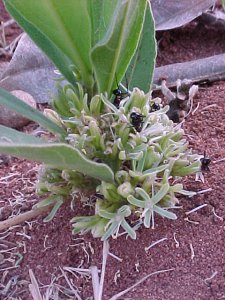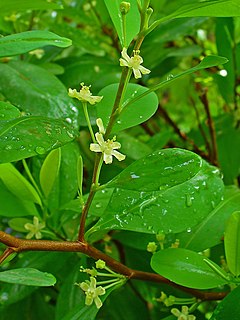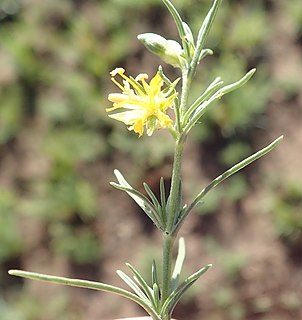
Oxalidales is an order of flowering plants, included within the rosid subgroup of eudicots. Compound leaves are common in Oxalidales and the majority of the species in this order have five or six sepals and petals. The following families are typically placed here:

Tiburcio Vasquez was a Californio bandido who was active in California from 1854 to 1874. The Vasquez Rocks, 40 miles (64 km) north of Los Angeles, were one of his many hideouts and are named after him.

Hydrophylloideae is a subfamily of the flowering plant family Boraginaceae. Their taxonomic position is somewhat uncertain. Traditionally, and under the Cronquist system, they were given family rank under the name Hydrophyllaceae, and treated as part of the order Solanales. More recent systems have recognised their close relationship to the borage family, Boraginaceae, initially by placing Hydrophyllaceae and Boraginaceae together in an order Boraginales, and most recently by demoting Hydrophyllaceae to a subfamily of Boraginaceae. However the placement and circumscription of Boraginaceae is still uncertain: it is unplaced at order level, and there is some prospect of it being split up again in future.

The Potamogetonaceae, commonly referred to as the pondweed family, is an aquatic family of monocotyledonous flowering plants. The roughly 110 known species are divided over six genera. The largest genus in the family by far is Potamogeton, which contains about 100 species.

The Legislative Assembly is the legislative branch of the government of El Salvador.

Virola is a genus of medium-sized trees native to the South American rainforest and closely related to other Myristicaceae, such as nutmeg. Species are known commonly as epená, patricá, or cumala. They have glossy, dark green leaves and clusters of tiny yellow flowers, and may emit a pungent odor.

The Peru national basketball team is administrated by the Peru Basketball Federation (F.D.P.B.).

Chrysobalanaceae is a family of flowering plants, consisting of trees and shrubs in 18 genera and about 533 species of pantropical distribution with a centre of diversity in the Amazon. Some of the species contain silica in their bodies for rigidity and so the mesophyll often has sclerenchymatous idioblasts. The widespread species Chrysobalanus icaco produces a plum-like fruit and the plant is commonly known as the coco plum.

Dichapetalaceae is a family of flowering plants, consisting of 3 genera and about 170 species. Members of this family are trees, shrubs or lianas found in tropical and subtropical regions of the world.

Erythroxylaceae is a family of flowering trees and shrubs consisting of 4 genera and 271 species. The four genera are AneulophusBenth., ErythroxylumP.Browne, NectaropetalumEngl., and PinacopodiumExell & Mendonça. The best-known species are the coca plants, including the species Erythroxylum coca, the source of the drug cocaine.

Picrodendraceae is a family of flowering plants, consisting of 80 species in 24 genera. These are subtropical to tropical and found in New Guinea, Australia, New Caledonia, Madagascar, continental Africa, and tropical America. Its closest relatives are Phyllanthaceae.

Pittosporaceae is a family of flowering plants that consists of 200–240 species of trees, shrubs, and lianas in 9 genera. Habitats range from tropical to temperate climates of the Afrotropical, Indomalayan, Oceanian, and Australasian realms. The type genus is Pittosporum Banks ex Gaertn.

Guatemala competed at the 1988 Summer Olympics in Seoul, South Korea. 28 competitors, 25 men and 3 women, took part in 16 events in 8 sports.
Perebea is a genus of plant in family Moraceae.

Pseudolmedia is a flowering plant genus in the mulberry family (Moraceae). Species are found in southern Mexico, the Caribbean, and Meso- and South America. They are known in Latin America as lechechiva and used for timber, construction wood, and sometimes in folk medicine.

Vahlia is a genus of herbs and subshrubs that grow in Africa and the Indian subcontinent. There are at least five species.

The Mafia Dolls, is a Colombian telenovela created by Andrés López and Juan Camilo Ferrand and that premiered on Caracol Televisión on 28 September 2009, based on the book Las fantásticas written by the same creators of the series.
Amores Cruzados is a telenovela produced by TV Azteca and Caracol TV Internacional. It premiered in 2006. The protagonists are David Zepeda, Michel Gurfi, Ana Lucia Dominguez and Patricia Vasquez. The telenovela was filmed in Mexico and Colombia.
Vale todo, is a telenovela co-produced in 2002 by the television Rede Globo and Telemundo Hispanic arm of the U.S. network NBC. The soap opera was an adaptation of the 1988 Brazilian telenovela Vale Tudo and was released for the U.S. Hispanic market on June 17, at 21.00. Starring Mexican actress Itatí Cantoral and Peruvian actor Diego Bertie, co-starring Argentine Javier Gómez, Ana Claudia Talancon and participation of actress Zully Montero.
The following lists events in the year 2019 in Guatemala.















